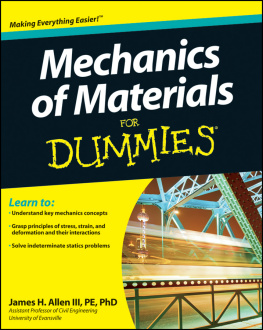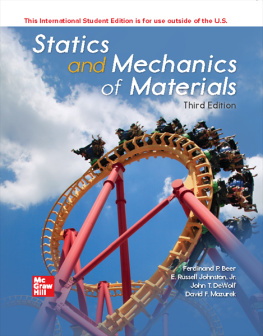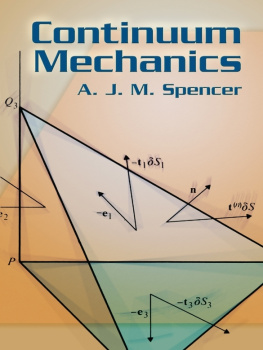Mechanics of Materials For Dummies
by James H. Allen III, PE, PhD
Mechanics of Materials For Dummies
Published by
Wiley Publishing, Inc.
111 River St.
Hoboken, NJ 07030-5774
www.wiley.com
Copyright 2011 by Wiley Publishing, Inc., Indianapolis, Indiana
Published simultaneously in Canada
No part of this publication may be reproduced, stored in a retrieval system or transmitted in any form or by any means, electronic, mechanical, photocopying, recording, scanning or otherwise, except as permitted under Sections 107 or 108 of the 1976 United States Copyright Act, without either the prior written permission of the Publisher, or authorization through payment of the appropriate per-copy fee to the Copyright Clearance Center, 222 Rosewood Drive, Danvers, MA 01923, (978) 750-8400, fax (978) 646-8600. Requests to the Publisher for permission should be addressed to the Permissions Department, John Wiley & Sons, Inc., 111 River Street, Hoboken, NJ 07030, (201) 748-6011, fax (201) 748-6008, or online at http://www.wiley.com/go/permissions.
Trademarks: Wiley, the Wiley Publishing logo, For Dummies, the Dummies Man logo, A Reference for the Rest of Us!, The Dummies Way, Dummies Daily, The Fun and Easy Way, Dummies.com, Making Everything Easier, and related trade dress are trademarks or registered trademarks of John Wiley & Sons, Inc. and/or its affiliates in the United States and other countries, and may not be used without written permission. All other trademarks are the property of their respective owners. Wiley Publishing, Inc., is not associated with any product or vendor mentioned in this book.
Limit of Liability/Disclaimer of Warranty: The publisher and the author make no representations or warranties with respect to the accuracy or completeness of the contents of this work and specifically disclaim all warranties, including without limitation warranties of fitness for a particular purpose. No warranty may be created or extended by sales or promotional materials. The advice and strategies contained herein may not be suitable for every situation. This work is sold with the understanding that the publisher is not engaged in rendering legal, accounting, or other professional services. If professional assistance is required, the services of a competent professional person should be sought. Neither the publisher nor the author shall be liable for damages arising herefrom. The fact that an organization or Website is referred to in this work as a citation and/or a potential source of further information does not mean that the author or the publisher endorses the information the organization or Website may provide or recommendations it may make. Further, readers should be aware that Internet Websites listed in this work may have changed or disappeared between when this work was written and when it is read.
For general information on our other products and services, please contact our Customer Care Department within the U.S. at 877-762-2974, outside the U.S. at 317-572-3993, or fax 317-572-4002.
For technical support, please visit www.wiley.com/techsupport.
Wiley also publishes its books in a variety of electronic formats and by print-on-demand. Some content that appears in standard print versions of this book may not be available in other formats. For more
information about Wiley products, visit us at www.wiley.com .
Library of Congress Control Number: 2011926319
ISBN: 978-0-470-94273-4 (pbk); 978-1-118-08899-9 (ebk); 978-1-118-08900-2 (ebk); 978-1-118-08901-9 (ebk)
Manufactured in the United States of America
10 9 8 7 6 5 4 3 2 1

About the Author
James H. Allen III, PE, PhD, serves on the civil engineering faculty at the University of Evansville, where he teaches statics, mechanics of materials, structural analysis, and structural design courses. Dr. Allen received his Ph.D. from the University of Cincinnati in structural engineering and performed his undergraduate work at the University of Missouri-Rolla (now the Missouri University of Science and Technology).
Dedication
For my loving wife, Miranda.
Authors Acknowledgments
I wish to thank the many people associated with the creation of this book, including the dedicated staff at Wiley. My continued appreciation is extended to my senior project editor, Alissa Schwipps, and my copy editor, Megan Knoll, for their continued guidance in this project. Id also like to thank Tracy Boggier and the folks at Wileys Composition Services department for their help in the completion of this endeavor.
Publishers Acknowledgments
Were proud of this book; please send us your comments through our online registration form located at www.dummies.com/register/.
Some of the people who helped bring this book to market include the following:
Acquisitions, Editorial, and Media Development
Senior Project Editor: Alissa Schwipps
Acquisitions Editor: Tracy Boggier
Copy Editor: Megan Knoll
Assistant Editor: David Lutton
Technical Editors: Guillermo Ramirez, PE, PhD; Dr. Thomas Siegmund
Editorial Manager: Christine Meloy Beck
Editorial Assistants: Rachelle Amick, Jennette ElNaggar, Alexa Koschier
Cover Photo: iStockphoto.com/Nikada
Cartoons: Rich Tennant (www.the5thwave.com)
Composition Services
Project Coordinator: Katherine Crocker
Layout and Graphics: Carl Byers, Carrie A. Cesavice, Cheryl Grubbs, Corrie Socolovitch, Laura Westhuis
Proofreader: Melissa D. Buddendeck
Indexer: Becky Hornyak
Special Help
Danielle Voirol
Publishing and Editorial for Technology Dummies
Richard Swadley , Vice President and Executive Group Publisher
Andy Cummings , Vice President and Publisher
Mary Bednarek , Executive Acquisitions Director
Mary C. Corder , Editorial Director
Publishing for Consumer Dummies
Diane Graves Steele , Vice President and Publisher
Composition Services
Debbie Stailey , Director of Composition Services
Introduction
S tudents undertaking a mechanics of materials class often find themselves facing a common dilemma: In their basic statics and dynamics classes, they focused on dealing exclusively with a key set of assumptions namely, that objects subjected to load dont deform but mechanics of materials throws many of those assumptions out the window.
Mechanics of materials is often your first foray into the real world from the land of theory in mechanics and physics. This class is where you start to take your basic understanding of the world around you and shape your surroundings to perform specific tasks; that is, you design stuff. This point is where I tell students that with a bit of knowledge, you can become quite dangerous.
Mechanics of materials at its core is still a very theoretical class, but it quickly takes these basic theories and applies them in new and unfamiliar ways. Thats why Ive written Mechanics of Materials For Dummies: to help make your transition from theoretical to practical as smooth and simple as possible. My goal in this text is to illustrate the basic theory while showing you how to actually apply these theories to real-world applications.
About This Book
No mechanics of materials book can possibly show you how to analyze every type of problem you may come across. Most mechanics of materials textbooks focus on complex derivations and variables that result in several relatively simple formulas without providing a whole lot of explanation along the way.














